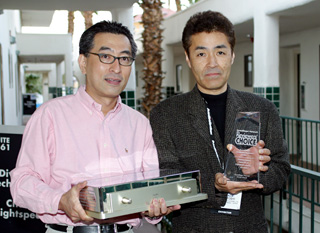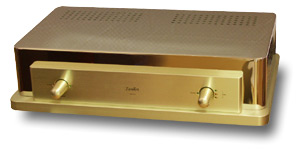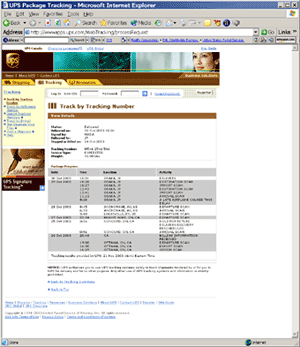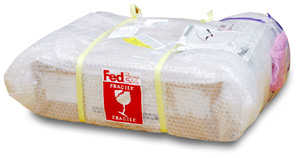![[SoundStage!]](../sslogo3.gif) The Traveler The TravelerBack Issue Article |
|
December 2003 Halfway Around the World, and Then Some
In mid-October I got word. That word came late one night in Ottawa, early in the morning in Asia, when Hideo Kitazawa of Singapore-based RTL Audio gave me the news: Zanden's Model 5000 Mk II DAC -- recipient of a Reviewers’ Choice nod in 2002 and a SoundStage! Network end-of-the-year award -- had been eclipsed not just once, but twice! Word spread fast; within moments I was on the phone to editor-in-chief Marc Mickelson. But first some background on the Model 5000. Late in 2001, I received e-mail from Mr. Kitazawa inquiring if I would like to review the Model 5000 DAC from a Japanese company called Zanden Audio. At that point the DAC was in its Mk II iteration. Not knowing a thing about the company except what I could learn from Zanden’s website, I agreed. After all, I trusted Mr. Kitazawa’s judgment in unearthing previously unknown goods because he had a successful track record of doing such -- he’s the person who introduced us to the Orthospectrum AR-2000 device that can work wonders with some CD players. A week or so later Zanden’s Model 5000 Mk II arrived. The box came delivered to my door by FedEx, and within minutes I had the DAC unboxed and sitting on my hardwood floor. I remember that time well because I was stunned for a moment or two, but when I came to I immediately picked up the phone and called Marc Mickelson. "Marc, you’ll never believe this thing. I have no idea what it costs, but it must cost something because it’s one of the most gorgeous pieces of audio gear I’ve ever had here. I mean, you, you, you’ve got to see it." Indeed, the 5000 Mk II with its gorgeously sculpted chassis is a piece of audio art -- a stark contrast to the plain heavy-duty faceplate slapped on to a box-shaped aluminum chassis that we’re so used to seeing, even with some very expensive gear. Pictures never do it justice. In fact, so many admirers want to get close to the 5000 that I feel as if I should get one of those glass boxes like they use in jewelry stores and museums to put around it just to protect it from probing fingers. I hate smudge marks on its shiny cover.
To get that glorious sonic performance the folks at Zanden Audio use some rather esoteric technology -- making the already-special Model 5000 just a little bit more of a standout. The 5000 is a tube-based digital-to-analog converter that uses no oversampling or upsampling whatsoever, and at its heart are pure-16-bit DACs sourced from Philips, along with a proprietary filtering circuit created by Zanden. At $9800 USD and produced in limited quantities, the Model 5000 is reserved for a select clientele though. But for about a year now I knew that the 5000 Mk II I’d reviewed wasn’t Zanden’s best offering anymore. About a year ago, designer Kazutoshi Yamada found ways to improve the noise performance of the 5000, and so a Mk III was born. Marc Mickelson, one who is equally adept at discerning world-class source components, reviewed that iteration and declared the Mk III every bit the winner the Mk II was. Like the Mk II, the Mk III was named a Reviewers’ Choice product based on state-of-the-art performance, which kept it on the list in 2003. And all this brings me to that e-mail that arrived late one night in October, sent early in the morning from Asia. Mr. Kitazawa let me know that Mr. Yamada got "full of inspiration to experiment on more digital-noise-related problems" and now the 5000 has been improved again. Even the Mk III is now old-school; the Mk IV version is where it’s at. Pack up the Mk II, he told me, and send it back to Japan where Mr. Yamada himself can upgrade it to the current status. So into the original packaging the Model 5000 Mk II went for its trip back to Japan -- halfway around the world, and then some, as I watched it travel through cities I never dreamed it would get to, all courtesy of UPS’s and FedEx’s tracking systems on the Internet. UPS is the main shipper I use, and while some have dubbed them the "brown bashers" for the alleged mishandling of some products, I’ve never sent or received a damaged parcel -- yet -- something I attribute to Jim, the UPS guy who handles 99% of my pickups and deliveries. Jim always comes armed with a cart -- he knows my shipments are usually quite heavy. He also knows that my shipments are usually valuable, and that I insure them adequately. So if they get dropped or smashed someone will be paying. He always treats my stuff well, and when he saw where this shipment was going and its value his eyebrows raised and he said, "To Japan! Oh my, this is going to cost you plenty." And it did. But away the the Model 5000 Mk II went on Jim’s cart in search of its birthplace.
I sent the package on October 21 and watched online for three days where I saw absolutely nothing. For whatever reason, the package didn't get into the system right away. Finally, on October 24th it popped up. The 5000 Mk II had arrived in...Ottawa. Three days and the DAC hadn’t moved an inch. The next day I checked again and found that the package had gone from Ottawa, Ontario to Concord, Ontario, where it was being held "for future delivery." Two days later it went to Mount Hope, Ontario. So in six days my package hadn’t even left the province, let alone the country or the continent. What’s more, I had no idea where Mount Hope was. When I plugged the name into MapQuest, it couldn’t find it either. My initial thought was, This is going to take months to get to Japan. And I couldn’t help but wonder if Jim was walking it there himself using his cart. On October 28, though, the package had miraculously shot over to Louisville, Kentucky. Finally, it had left the country! At this point I thought it would surely head due west, perhaps make a pit stop in Los Angeles -- giving the 5000 Mk II a chance to see Disneyland and Universal Studios from the cargo hold of a UPS plane -- before it made the big leap over the Pacific. But no -- for whatever reason it then shot northeast, all the way to Anchorage, Alaska. The 5000 Mk II hadn’t moved more than probably a few hundred kilometers in six days and now it was going thousands in a matter of hours. But it was still no closer to its destination. But then a bit of inspiration struck. Perhaps UPS views the world as though it's a roller coaster. They start a package at its lowest point, and then they pull it as high up as they can -- a long wait in Ontario, then to Kentucky, then way up to Alaska -- and from there it's all speed. That must have been it, because on October 29 the 5000 Mk II made the big run to Japan. By 8:28 that morning the Model 5000 Mk II was waiting in customs on the other side of the Pacific -- in the right country this time. In fact, it would have been earlier, but the tracking system told me that "a late airplane caused this delay." A late airplane! What about the six days the 5000 Mk II was left to lounge around in Ontario? There was no mention of that causing any delay. So from Anchorage to Osaka it went lickety-split. And after the customs officials figured out the Model 5000 Mk II was not an illegal alien but a returning resident of Japan, it was released and delivered to Mr. Yamada’s workshop on October 30. And Mr. Yamada works fast. No sooner had I penned an e-mail to find out not if the DAC arrived, but if it arrived safely, I was told that it would be shipped back very soon.
So now the Model 5000 is back, although I haven’t yet cracked open the box, let alone removed the bubble wrap and straps, to make sure all is OK inside. What I know is what I’ve been told -- the Model 5000 left as a Mk II and has returned as a full-fledged Mk IV. Look for a follow-up review of this very interesting product sometime in 2004. ...Doug Schneider
|
|
|
|
![[SoundStage!]](../sslogo3.gif) All Contents All ContentsCopyright © 2003 SoundStage! All Rights Reserved |

 And the 5000 Mk II
sounds every bit as good as it looks -- making it world-class through and through. I
suspect that many of those who have already jumped ship and joined the SACD and DVD-A
bandwagons have never really heard their CDs the way they can sound. And although
the Model 5000 Mk II can’t necessarily eclipse every other digital source in every
way (no source can, though), its strength is crystalline purity through the mids and highs
along with a sense of immediacy and transparency that few sources can approach. It's so
good that I'm in no rush whatsoever to invest in a limited number of high-resolution
releases; I'm re-learning my CD collection through this DAC, and of course buying many
more new CDs.
And the 5000 Mk II
sounds every bit as good as it looks -- making it world-class through and through. I
suspect that many of those who have already jumped ship and joined the SACD and DVD-A
bandwagons have never really heard their CDs the way they can sound. And although
the Model 5000 Mk II can’t necessarily eclipse every other digital source in every
way (no source can, though), its strength is crystalline purity through the mids and highs
along with a sense of immediacy and transparency that few sources can approach. It's so
good that I'm in no rush whatsoever to invest in a limited number of high-resolution
releases; I'm re-learning my CD collection through this DAC, and of course buying many
more new CDs. Armed with the tracking
number from my waybill, I bookmarked UPS’s tracking system and readied myself for
play-by-play action to ensure that the Model 5000 Mk II was going to get from Ottawa to
Osaka without a glitch. Because I sent it "expedited," I mistakenly thought that
that would mean fast, too. Oh, what a confusing web UPS weaves with their travel plans.
Armed with the tracking
number from my waybill, I bookmarked UPS’s tracking system and readied myself for
play-by-play action to ensure that the Model 5000 Mk II was going to get from Ottawa to
Osaka without a glitch. Because I sent it "expedited," I mistakenly thought that
that would mean fast, too. Oh, what a confusing web UPS weaves with their travel plans. And so it was. A short
while later I received another e-mail from Mr. Kitazawa, in the morning this time -- he
was likely working late into the night. He gave me the FedEx tracking number -- the 5000
Mk IV was shipped International Priority Service and was already on its way. And boy oh
boy, does that service move fast. One day, door to door -- even halfway around the world.
There are no six days of hibernating in Ontario, and certainly no freezing in Alaska. By
the time I pulled up the FedEx tracking system, their delivery guy was knocking at my
door. From Osaka to Ottawa without a rest in between, as if a giant slingshot had
catapulted it all the way here.
And so it was. A short
while later I received another e-mail from Mr. Kitazawa, in the morning this time -- he
was likely working late into the night. He gave me the FedEx tracking number -- the 5000
Mk IV was shipped International Priority Service and was already on its way. And boy oh
boy, does that service move fast. One day, door to door -- even halfway around the world.
There are no six days of hibernating in Ontario, and certainly no freezing in Alaska. By
the time I pulled up the FedEx tracking system, their delivery guy was knocking at my
door. From Osaka to Ottawa without a rest in between, as if a giant slingshot had
catapulted it all the way here.